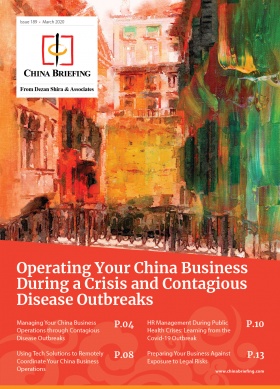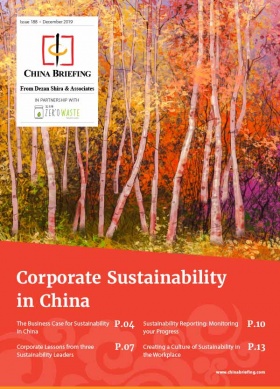The US Needs an Urgent Medical Care FTA with China
As the US appears to be on the cusp of becoming the next major center of the COVID-19 pandemic, trade issues with China are hampering its ability to source product. In fact, just 10 days ago, President Trump complained that China had a ‘stranglehold’ on US supplies and inferred that China was essentially in global control of world pharmaceuticals. But is this true?
Trade in global pharmaceuticals is regulated by a 1995 agreement known as the ‘Pharmaceutical Tariff Elimination Agreement’, brokered by the WTO. This was introduced to specifically prevent any one nation from becoming dominant, and also to allow the global spread of medicinal support wherever it was needed and without hindrance due to import tariff impositions. It is known as a “zero-for-zero initiative” to eliminate duties reciprocally in a particular industrial sector.
Signed onto by a handful of countries who represented 90 percent of the global pharmaceutical producers of that time, including the US, the EU, Japan, Canada, Norway, Switzerland, and Australia, the agreement initially covered approximately 7,000 items. These included formulated or dosed medicines, medicines traded in bulk, active pharmaceutical ingredients (APIs), and other chemical intermediaries in finished pharmaceuticals. Signatories agreed to expand the list in 1996, 1998, 2006, and 2010; it now covers more than 10,000 products. Tariffs were eliminated on a most-favored-nation basis, meaning it was extended to imports from all WTO members, not just parties to the agreement.
Nevertheless, the Pharmaceutical Tariff Elimination Agreement has not been updated in a decade. According to a report published by the Hinrich Foundation, this has resulted in about 1,000 finished products and 700 ingredients being left out of the WTO agreement’s coverage and thereby subject to hundreds of millions of dollars in customs duties. Interestingly, this period coincided with the growth of China and India manufacturing capacity. Between 2009 and 2018, trade in products covered by the WTO agreement rose from US$1.3 trillion in 2009 to US$1.9 trillion but the WTO duty-free treatment of pharmaceuticals decreased from 81 percent in 2009 to 78 percent in 2018. One reason for this was the failure of either China or India to reach a free trade agreement (FTA) with the US or become signatories to the WTO agreement.
The Heinrich Foundation report also notes that over the past decade, China has increasingly exported inputs specific to the pharmaceutical industry – including antibiotics, hormones, and vitamins – as well as medical equipment like diagnostic reagents, gloves, syringes, and medical devices. India has also increased its exports of all types of pharmaceuticals, particularly, ingredients and generic drugs. However, even when taking this into consideration, China and India still only account for 5.4 percent of global exports in health-related products covered by the original WTO agreement.
The situation has now come back to haunt the US. The US has attempted to include pharmaceuticals in bilateral, rather than multilateral trade agreements with China and India, and has failed. This is partially because the US did not wish either country to develop and compete with its own, massive pharma sector, and sought to limit Chinese and Indian capacity. Yet, China and India both needed to upgrade their own industries, both, to supply their respective billion-plus populations and because developing a domestic pharmaceutical industry would be a major source of national employment and revenue.
Meanwhile, not being signatories to the 1995 agreement, major emerging economies like China, India, and Brazil are subject to import duties on US pharmaceutical products. A 2017 report by the European Centre for International Political Economy determined that tariffs on final prices add an annual burden of up to US$6.2 billion in China for the importation of pharmaceutical products. It is therefore not surprising it has developed its own industry, as have Brazil and India. We have written about opportunities in China’s domestic healthcare industry post the pandemic in the article Investment Opportunities In China’s Healthcare Sector After COVID-19.
The COVID-19 pandemic has ripped open global fault lines. US pharma policy towards China, India, and Brazil has been found to be completely erroneous, to which can be added a large dose of recent bellicose American attitudes towards these trade partners, and China especially.
With the US now facing a shortage of equipment, it has now been asking overseas for supplies. But some 20 countries have already announced a ban on the export of medical gear and personal protective equipment (PPE) like masks, gloves, and protective suits worn by medical professionals, including India. Interestingly, many of those countries were never included in the 1995 WTO deal, and are now prominent manufacturers like China and Russia.
Added to the irony is the fact that US President Donald Trump has asked for ventilators to be shipped from South Korea, just weeks after threatening their President with thousands of Korean job losses and the closure of bases – keeping North Korea at arms’ length – should Seoul not contribute an additional US$5 billion for the upkeep of US bases in the country.
The US is about to enter into a domestic crisis where it needs outside help. Yet, the countries it requires assistance from already have their own domestic needs or are working to manage the outbreak in their respective territories. Many have felt humiliated by recent US aggression over trade. Linking pharmaceuticals with overall FTAs has proven to be a major policy error. What the US needs right now are specific FTAs with China, India, Brazil, and Russia over pharmaceutical and medical supplies. In this Trumpian era of Trade Wars and Sanctions, the danger now for the US is that those calls, even if they are made, might well take some time to answer.
This article uses data from the piece ‘Free Trade in Medicines and Supplies is the Healthiest Approach’ published by the Hinrich Foundation in order to better illustrate the US-China historical trade position. The original article, including trade figures, can be found here.
About Us
China Briefing is written and produced by Dezan Shira & Associates. The practice assists foreign investors into China and has done since 1992 through offices in Beijing, Tianjin, Dalian, Qingdao, Shanghai, Hangzhou, Ningbo, Suzhou, Guangzhou, Dongguan, Zhongshan, Shenzhen, and Hong Kong. Please contact the firm for assistance in China at china@dezshira.com.
We also maintain offices assisting foreign investors in Vietnam, Indonesia, Singapore, The Philippines, Malaysia, and Thailand in addition to our practices in India and Russia and our trade research facilities along the Belt & Road Initiative.
- Previous Article Webinar Alert: Reconfiguring Your China Business After COVID-19
- Next Article Jack Ma Steps in to Provide US and Asia COVID-19 Aid, Medical Supplies






